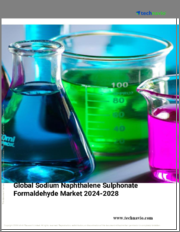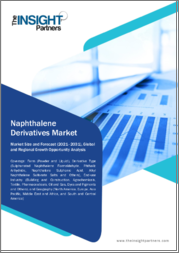
|
시장보고서
상품코드
1410133
세계 나프탈렌 유도체 시장 예측(2023-2028년)Naphthalene Derivatives Market - Forecasts from 2023 to 2028 |
||||||
세계 나프탈렌 유도체 시장 규모는 2021년에 18억 4,345만 2,000달러에 이르고, CAGR 3.4%로 성장하고, 2028년에는 23억 2,990만 1,000달러에 달할 것으로 예측되고 있습니다.
나프탈렌 유도체는 무취이며 휘발성이 낮기 때문에 농약, 섬유 및 건설 분야에서 널리 사용됩니다. 나프탈렌 유도체는 소금, 알코올 등 다양한 조성으로 이용할 수 있기 때문에 산업용도 확대로 시장 확대에 박차가 걸릴 것으로 예측됩니다. 사람들의 라이프스타일 변화와 섬유·건설산업 투자 증가로 산업화와 도시화의 진전이 시장 확대로 이어질 것으로 예측됩니다. 다양한 소금과 산을 사용할 수 있으며 새로운 나프탈렌 화합물이 발견됨에 따라 나프탈렌 유도체 시장의 성장이 가속화 될 것으로 예상됩니다.
섬유 산업 확대
알킬나프탈렌술폰산염은 침지성과 소포성 때문에 섬유산업에서 표백이나 염색에 자주 사용되고 있습니다. 상업적인 염료의 대부분을 차지하는 아조 염료는 섬유 산업에서 널리 이용됩니다. 알킬 나프탈렌 술폰산염은 다양한 색의 전구체로 사용됩니다. 알킬 나프탈렌 술폰산염은 다양한 색상이 있으며 다양한 소재에 사용됩니다. 염료 제조의 중간체로서, 나프틸아민이나 황산염 등의 다른 나프탈렌 유도체도 도움이 되어, 나프탈렌 유도체 시장 규모를 확대하고 있습니다.
건설 산업 수요 증가
나프탈렌 유도체는 휘발성이 낮고 냄새가 없기 때문에 건설 산업에서 가장 일반적으로 사용됩니다. 건설산업에서는 콘크리트 중의 고형 혼합물의 평활성을 높이고 구조물의 골조를 강화하기 위해 나프탈렌이 많이 사용되고 있기 때문에 예측 기간 동안 나프탈렌 유도체 시장은 세계적으로 확대될 것으로 예측됩니다. 설폰화 나프탈렌포름알데히드(SNF)는 건설산업에서 콘크리트 혼합물의 초가소제로 응용되고 있기 때문에 유도체 중에서 가장 큰 시장 점유율을 차지하고 있으며 예측 기간 동안에도 시장의 주도권을 잡는 것으로 예측됩니다.
제약 산업에서의 사용 증가
제약 산업에서 나프탈렌 유도체는 새로운 의약품과 치료법의 개발에 사용됩니다. 따라서 독성이 낮은 의약품 개발을 위한 의약화학 연구에 대한 관심이 높아지고 있으며, 향후 수년간 나프탈렌 유도체 수요가 증가할 것으로 예측되고 있습니다. 또한, 나프탈렌 유도체는 심장 우회 수술 및 이식 후 뇌 장애, 뇌졸중, 뇌 허혈, 외상 및 기타 질병으로 인한 척수 손상과 같은 급성 신경 증상을 포함한 다양한 포유류 신경 문제의 치료에도 사용됩니다.
아시아태평양이 나프탈렌 유도체 시장을 독점할 것으로 예측
예측 기간 동안 아시아태평양은 나프탈렌 유도체 시장을 선도할 것으로 예상됩니다. 섬유·의류 산업은 아시아태평양에 집중하고 있으며, 아시아태평양은 세계에서 가장 인구가 많은 지역이기도 합니다. 경제 확대는 소비자의 소비력을 향상시키고 섬유 제품을 포함한 상품의 1인당 소비를 밀어 올려 아시아태평양의 섬유 산업의 상승을 촉진하고 있습니다. 생산 비용이 낮기 때문에 중국은 섬유제품·의류품의 제조·수출에 있어서 세계 톱입니다. 싱가포르는 섬유 산업의 지역 중심지 역할을 합니다. 아시아태평양의 섬유 산업은 인도네시아 의류 산업에서 큰 혜택을 받고 있습니다.
대량의 유해화학물질
나프탈렌과 그 유도체는 방충제, 담배 연기, 장작 연소, 우발적인 유출 등에 의해 대기 중에 방출되어 환경 위험을 유발합니다. 토양 입자는 나프탈렌과 그 화합물을 물에 쉽게 흡수합니다. 나프탈렌은 휘발성이 높기 때문에 대기 중에 기화하기 쉽습니다. 나프탈렌은 수분과 햇빛의 존재하에 쉽게 1- 또는 2-나프톨로 변화하여 대기 중 독성을 증가시키고 많은 건강 위험을 초래합니다. 나프탈렌의 섭취, 흡입, 피부 접촉으로 인한 급성 노출로 인해 용혈성 빈혈, 간 장애, 뇌 장애가 발생할 수 있습니다. 인간이나 쥐 모두 만성 나프탈렌 노출은 망막 장애를 일으킬 수 있습니다.
변동하는 에너지 가격과 과잉 생산 능력
나프탈렌과 그 유도체의 생산에는 석유(원유)와 콜타르 증류가 주로 사용됩니다. 나프탈렌과 그 유도체의 약 90%는 콜타르의 증류에 의해 생산됩니다. 산업용 나프탈렌 수요는 콜타르의 비용과 사용량의 변화에 크게 영향을 받고 있으며, 이는 시장의 과제가 되고 있습니다. 나프탈렌, 크레졸, 안트라센, 페놀과 같은 콜타르 딥 드로잉 제품의 주요 생산국인 중국은 최근 급속한 확장으로 대규모 생산 능력 과잉을 다루어야 했습니다. 수요 및 공급 불균형으로 콜타르 가격은 극적으로 하락했습니다.
시장 제품
Himadri는 초정제 등급의 나프탈렌을 제공하며 방충제, 중간체 및 염료 생산에 사용됩니다. 다단계 정제 장치에서 최첨단 기술을 사용하여 화학 처리된 나프탈렌 오일을 생성하고 정류탑에서 증류한 후 정제 장치로 추가 정제합니다. 출발 원료는 고온 거친 콜타르에서 일련의 증류탑에서 분별 제조되는 나프탈렌 오일입니다. 우리의 뛰어난 경험이 풍부한 직원은 목표 품질이 지속적으로 달성되도록 눈길을 끌고 있습니다. King Industries의 NA-LUBE KR 알킬화 나프탈렌 라인은 가장 광범위한 점도와 성능을 제공합니다. 알킬화 나프탈렌으로 불리는 고성능 그룹 V 베이스 오일은 단독으로 또는 그룹 II, 그룹 III, PAO와 같은 다른 베이스 오일의 개질제로서 이용될 수 있습니다. NA-LUBE KR의 알킬화 나프탈렌은 탁월한 열·열산화 안정성, 우수한 가수분해 안정성, 바니시 관리에 의해 첨가제와의 표면 경쟁을 일으키지 않고 고성능 윤활유의 수명을 향상 합니다. NA-LUBE KR 시리즈는 NSF에 등록된 HX-1 윤활 첨가제로, 우발적인 식품 접촉에 FDA 21 CFR을 준수하는 3가지 등급으로 구성되어 있습니다. Manish Minerals and Chemicals는 고품질의 정제 나프탈렌을 제조 및 판매하는 선도 기업입니다. 이 회사가 제공하는 나프탈렌 유도체는 불꽃 놀이의 특수 효과 중에서도 검은 연기와 의사 폭발을 만드는 데 사용됩니다. 나프탈렌은 매우 승화성이 높고, 벤젠, 알코올, 에테르, 클로로포름, 이황화탄소에는 녹지만 물에는 녹지 않습니다. 섬유 산업, 의류 산업, 농업 등에 응용할 수 있습니다. 또한 이 제품에서 상당한 검은 연기가 발생하므로 영화나 군사 훈련에 사용할 수 있습니다.
목차
제1장 서론
- 시장 개요
- 시장의 정의
- 조사 범위
- 시장 세분화
- 통화
- 전제조건
- 기준년과 예측년의 타임라인
제2장 조사 방법
- 조사 데이터
- 전제조건
제3장 주요 요약
- 조사 하이라이트
제4장 시장 역학
- 시장 성장 촉진요인
- 시장 성장 억제요인
- Porter's Five Forces 분석
- 산업 밸류체인 분석
제5장 나프탈렌 유도체 시장 : 형태별
- 소개
- 분말
- 액체
제6장 나프탈렌 유도체 시장 : 유래별
- 소개
- 콜타르
- 석유 베이스
- 기타
제7장 나프탈렌 유도체 시장 : 제품별
- 소개
- 설폰화 나프탈렌포름알데히드(SNF)
- 무수 프탈산
- 나프탈렌술폰산
- 나프톨류
- 알킬나프탈렌술폰산염
- 기타
제8장 나프탈렌 유도체 시장 : 최종 사용자 산업별
- 소개
- 페인트 및 코팅
- 건설
- 섬유
- 펄프 및 종이
- 석유 및 가스
- 의약품
- 기타
제9장 나프탈렌 유도체 시장 :지역별
- 소개
- 북미
- 미국
- 캐나다
- 멕시코
- 남미
- 브라질
- 아르헨티나
- 기타
- 유럽
- 독일
- 프랑스
- 영국
- 스페인
- 기타
- 중동 및 아프리카
- 사우디아라비아
- 아랍에미리트(UAE)
- 이스라엘
- 기타
- 아시아태평양
- 중국
- 일본
- 인도
- 한국
- 인도네시아
- 대만
- 기타
제10장 경쟁 환경과 분석
- 주요 기업과 전략 분석
- 신흥기업과 시장수익성
- 합병, 인수, 합의 및 협업
- 벤더 경쟁력 매트릭스
제11장 기업 프로파일
- Jfe Chemical Corporation
- Kao Corporation
- King Industries, Inc.
- Manish Minerals & Chemicals
- Monument Chemical Inc.
- PCC SE
- Trisha Speciality Chemical Pvt. Ltd.
- Akzo Nobel NV
- BASF SE
- Clariant AG
The naphthalene derivatives market is expected to grow at a CAGR of 3.4% from US$1,843.452 million in 2021 to US$2,329.901 million in 2028.
Naphthalene derivatives are widely employed in the agrochemical, textile, and construction sectors due to their odourless nature combined with low volatility. The availability of naphthalene derivatives in a variety of compositions, such as salts, alcohols, and others, is projected to spur market expansion due to their expanded range of industrial applications. Due to people's changing lifestyles and increased investment in the textile and construction industries, it is projected that growing industrialization and urbanization would lead to market expansion. The availability of various salts and acids and the discovery of new naphthalene compounds are predicted to accelerate naphthalene derivatives market growth.
Expanding textile industry
Due to their soaking and defoaming properties, alkyl naphthalene sulfonates are frequently used in the textile sector for bleaching and dying procedures. Azo dyes, which make up a sizable portion of commercial dyes, are widely utilised in the textile industry. Alkyl naphthalene sulfonates are used as a precursor in different colours. They come in a variety of colours and are used for various materials. As intermediates in the manufacture of dyes, some of the other naphthalene derivatives, such as naphthylamines and sulfuric acid salts, are also helpful which is increasing the naphthalene derivatives market size.
Rising demand in the construction industry
Due to their low volatility and lack of odour, naphthalene derivatives are most commonly used in the construction industry. The construction industry's significant use of naphthalene to increase the smoothness of solid mixes in concrete and strengthen the structure's framework is predicted to drive the expansion of the worldwide naphthalene derivatives market over the course of the forecast period. Due to its application as a superplasticizer in concrete mixtures in the construction industry, sulfonated naphthalene formaldehyde (SNF) accounted for the greatest market share among the derivatives and is predicted to rule the market studied over the projected period.
Increasing use in the pharmaceutical industry
In the pharmaceutical industry, naphthalene derivatives are used to create new pharmaceuticals and therapies. Therefore, the growing interest in medicinal chemistry research for the development of medicines with low toxicity is projected to increase demand for naphthalene derivatives in the upcoming years. Furthermore, naphthalene derivatives are also used to cure a range of neurological problems in mammals including acute neurological conditions such as cerebral impairments after cardiac bypass surgery and grafting, stroke, cerebral ischemia, and spinal cord damage as a result of trauma or other diseases.
Asia Pacific is projected to dominate the naphthalene derivatives market
During the projected period, the Asia Pacific region is anticipated to lead the naphthalene derivatives market. The textile and apparel industries are heavily concentrated in APAC, which also has the greatest population in the world. The expansion of the economy has improved consumer spending power, driving up per-capita consumption of commodities, including textiles, which is driving the rise in the APAC textiles industry. Due to its low production costs, China is the world's top manufacturer and exporter of textiles and garments. Singapore serves as a regional centre for the textile industry. The textile sector in APAC benefits greatly from Indonesia's garment industry.
High quantity of harmful toxic chemicals
Naphthalene and its derivatives can be discharged into the air via moth repellent, cigarette smoke, wood burning, and accidental spills, creating environmental risks. Soil particles easily absorb naphthalene and its compounds into water. They are easily able to vaporize into the atmosphere due to their volatility. In the presence of moisture and sunlight, naphthalene is readily transformed into 1- or 2-naphthol, which may rise the air toxicity and provide a number of health risks. Hemolytic anaemia, liver, and brain damage can result from acute exposure to naphthalene through ingesting, inhalation, or skin contact. In both humans and rats, chronic naphthalene exposure can result in retinal damage. which impedes the naphthalene derivatives market.
Fluctuating energy prices & overcapacity
Petroleum (crude oil) and coal tar distillation are the two main sources used in the production of naphthalene and its derivatives. About 90% of naphthalene and its derivatives are produced through the distillation of coal tar. Industrial naphthalene demand has been significantly impacted by changes in coal tar costs and usage, which presents a challenge to the market. Due to its recent rapid expansions, China, a significant producer of deep-processed coal tar products such as naphthalene, cresol, anthracene, and phenol, was forced to deal with massive overcapacity. Due to the imbalance in supply and demand, coal tar prices consequently fell dramatically.
Market products
- Himadri provides the ultra-refined grade of naphthalene, it is used in the production of mothballs, intermediates, and dyes. They use cutting-edge technology in multi-stage refining units to generate chemically treated naphthalene oil, which is then further purified in refiners after being distilled in rectification/fractionating columns. The starting material is naphthalene oil, which is fractionally produced in a series of distillation towers from high-temperature crude coal tar. Our highly qualified and experienced crew keeps a close eye on things to ensure that the goal quality is continuously met.
- The broadest range of viscosities and performance capabilities are provided by King Industries' NA-LUBE KR alkylated naphthalene line. High-performance Group V base oils called alkylated naphthalenes can be utilised on their own or as modifiers for other base oils like Group II, Group III, or PAOs. Alkylated naphthalenes from NA-LUBE KR improve the lifespan of high-performance lubricants without creating surface competition from additives thanks to their outstanding thermal and thermo-oxidative stability, excellent hydrolytic stability, and varnish management. The NA-LUBE KR series consists of three grades that are HX-1 lubricant additives registered with the NSF and FDA 21 CFR compliant for incidental food contact.
- Manish Minerals and Chemicals is a leading company that produces and distributes high-quality refined naphthalene. Naphthalene derivatives provided by them are utilised in the creation of black smoke and fake explosions, among other pyrotechnic special effects. It is extremely sublime and may dissolve in benzene, alcohol, ethers, chloroform, and carbon disulfide but not in water. They can be applied to the textile, apparel, and agricultural industries. A significant blast of black smoke is also produced by the product, which can be used for movies or military training.
Segmentation:
By Form
- Powder
- Liquid
By Source
- Coal-Tar
- Petroleum Based
- Others
By Product
- Sulphonated Naphthalene Formaldehyde (SNF)
- Phthalic Anhydride
- Naphthalene Sulphonic Acid
- Naphthols
- Alkyl Naphthalene Sulphonate Salts
- Others
By End-User Industry
- Paints and Coatings
- Construction
- Textile
- Pulp and Paper
- Oil and Gas
- Pharmaceutical
- Others
By Geography
- North America
- United States
- Canada
- Mexico
- South America
- Brazil
- Argentina
- Others
- Europe
- United Kingdom
- Germany
- France
- Spain
- Others
- Middle East and Africa
- Saudi Arabia
- UAE
- Israel
- Others
- Asia Pacific
- China
- Japan
- India
- South Korea
- Indonesia
- Thailand
- Others
TABLE OF CONTENTS
1. INTRODUCTION
- 1.1. Market Overview
- 1.2. Market Definition
- 1.3. Scope of the Study
- 1.4. Market Segmentation
- 1.5. Currency
- 1.6. Assumptions
- 1.7. Base, and Forecast Years Timeline
2. RESEARCH METHODOLOGY
- 2.1. Research Data
- 2.2. Assumptions
3. EXECUTIVE SUMMARY
- 3.1. Research Highlights
4. MARKET DYNAMICS
- 4.1. Market Drivers
- 4.2. Market Restraints
- 4.3. Porter's Five Force Analysis
- 4.3.1. Bargaining Power of Suppliers
- 4.3.2. Bargaining Power of Buyers
- 4.3.3. Threat of New Entrants
- 4.3.4. Threat of Substitutes
- 4.3.5. Competitive Rivalry in the Industry
- 4.4. Industry Value Chain Analysis
5. NAPHTHALENE DERIVATIVES MARKET, BY FORM
- 5.1. Introduction
- 5.2. Powder
- 5.3. Liquid
6. NAPHTHALENE DERIVATIVES MARKET, BY SOURCE
- 6.1. Introduction
- 6.2. Coal-Tar
- 6.3. Petroleum Based
- 6.4. Others
7. NAPHTHALENE DERIVATIVES MARKET, BY PRODUCT
- 7.1. Introduction
- 7.2. Sulphonated Naphthalene Formaldehyde (SNF)
- 7.3. Phthalic Anhydride
- 7.4. Naphthalene Sulphonic Acid
- 7.5. Naphthols
- 7.6. Alkyl Naphthalene Sulphonate Salts
- 7.7. Others
8. NAPHTHALENE DERIVATIVES MARKET, BY END-USER INDUSTRY
- 8.1. Introduction
- 8.2. Paints and Coatings
- 8.3. Construction
- 8.4. Textile
- 8.5. Pulp and Paper
- 8.6. Oil and Gas
- 8.7. Pharmaceutical
- 8.8. Others
9. NAPHTHALENE DERIVATIVES MARKET, BY GEOGRAPHY
- 9.1. Introduction
- 9.2. North America
- 9.2.1. USA
- 9.2.2. Canada
- 9.2.3. Mexico
- 9.3. South America
- 9.3.1. Brazil
- 9.3.2. Argentina
- 9.3.3. Others
- 9.4. Europe
- 9.4.1. Germany
- 9.4.2. France
- 9.4.3. United Kingdom
- 9.4.4. Spain
- 9.4.5. Others
- 9.5. Middle East And Africa
- 9.5.1. Saudi Arabia
- 9.5.2. UAE
- 9.5.3. Israel
- 9.5.4. Others
- 9.6. Asia Pacific
- 9.6.1. China
- 9.6.2. Japan
- 9.6.3. India
- 9.6.4. South Korea
- 9.6.5. Indonesia
- 9.6.6. Taiwan
- 9.6.7. Others
10. COMPETITIVE ENVIRONMENT AND ANALYSIS
- 10.1. Major Players and Strategy Analysis
- 10.2. Emerging Players and Market Lucrativeness
- 10.3. Mergers, Acquisitions, Agreements, and Collaborations
- 10.4. Vendor Competitiveness Matrix
11. COMPANY PROFILES
- 11.1. Jfe Chemical Corporation
- 11.2. Kao Corporation
- 11.3. King Industries, Inc.
- 11.4. Manish Minerals & Chemicals
- 11.5. Monument Chemical Inc.
- 11.6. PCC SE
- 11.7. Trisha Speciality Chemical Pvt. Ltd.
- 11.8. Akzo Nobel NV
- 11.9. BASF SE
- 11.10. Clariant AG



















